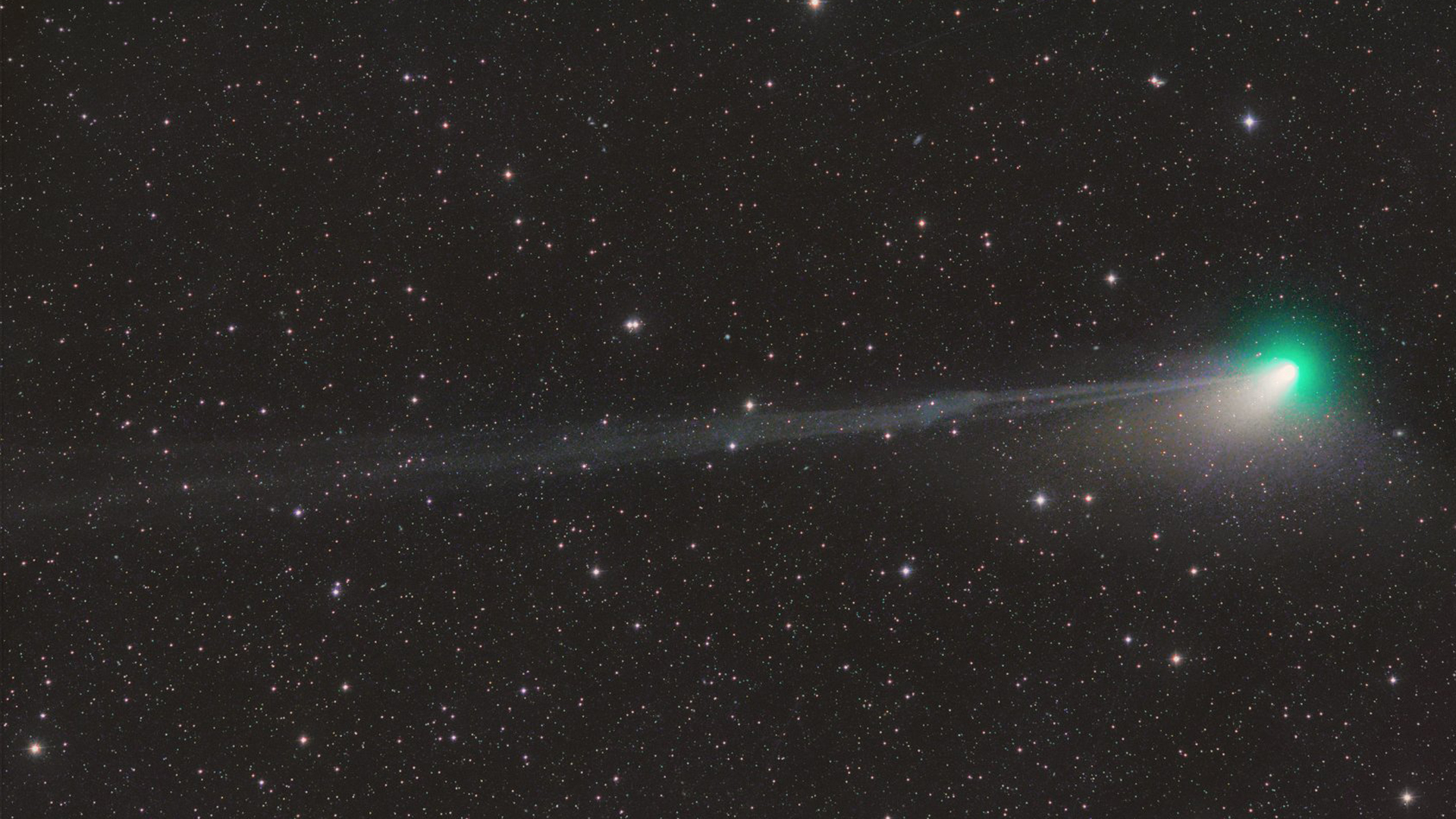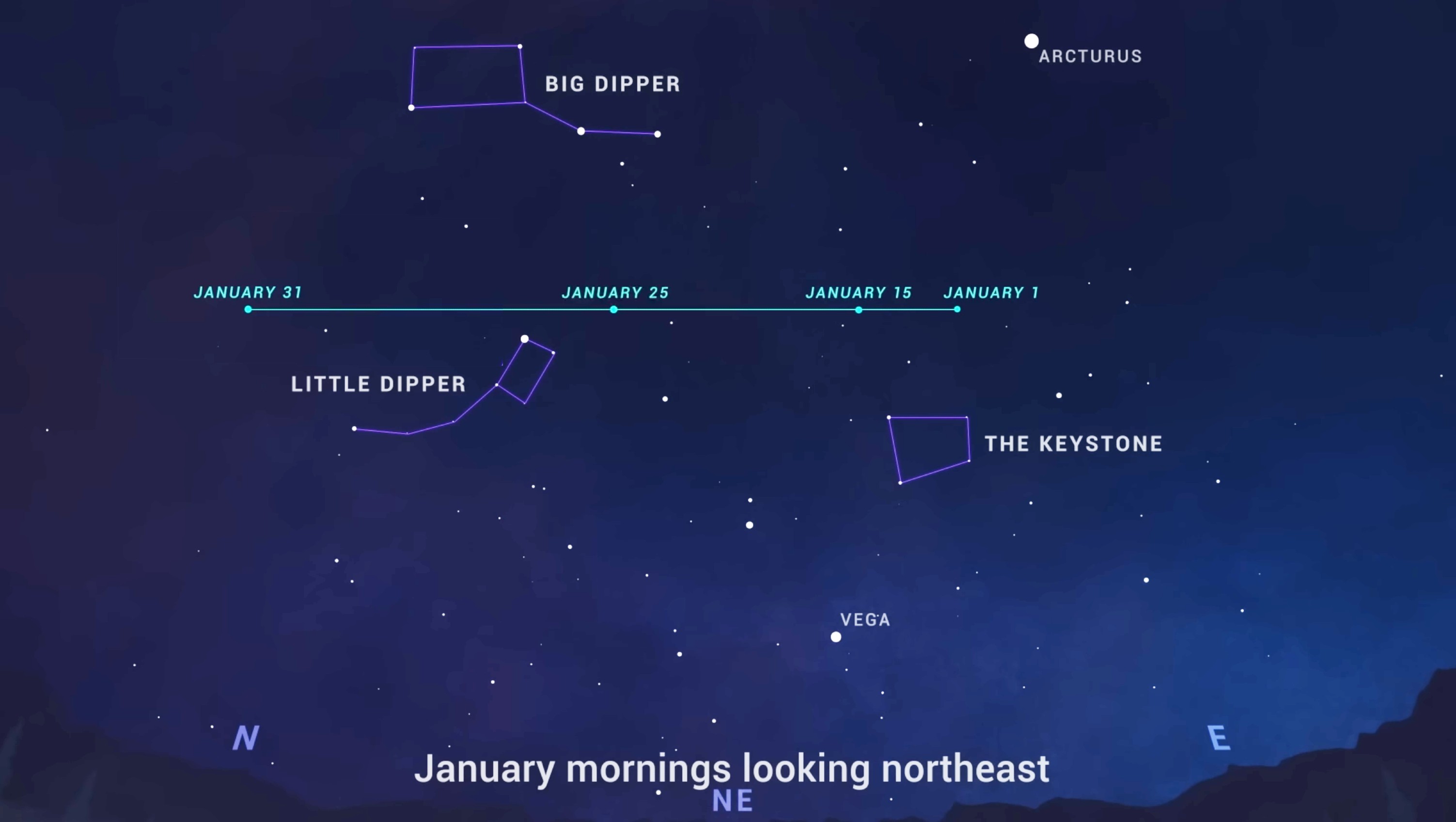Brilliant green comet loses part of its tail to solar storm in this stunning astrophotographer photo
This amazing photo of Comet C/2022 E3 (ZTF) was captured by comet hunter Michael Jäger

An image taken by an Austrian comet hunter reveals a disconnection in a stunning green comet's tail that may have been caused by turbulent space weather.
Seasoned astrophotographer Michael Jäger took this image of the Comet C/2022 E3 (ZTF) on Tuesday (Jan. 17) after driving 500 miles (800 kilometers) from Austria to Bavaria in Germany to get a clear view of the night sky. Jäger shared the image on Twitter, along with more photos video of the comet.
"The journey was not in vain," Jäger told Space.com in an email. He added that when it comes to capturing images of comets, an astrophotographer can waste no time as these icy balls change rapidly when they reach the warmer regions in the inner solar system.
Related: Amazing photos of gorgeously green Comet C/2022 E3 (ZTF)
More: How to view and photograph comets

Want to get a good look at the gorgeously green comet C/2022 E3 (ZTF)? We recommend the Celestron Astro Fi 102 as the top pick in our best beginner's telescope guide.
This particular image reveals what astronomers call a disconnection event, essentially a weakening in the comet's signature tail, which makes it look as if the tail was breaking off.
According to SpaceWeather.com, this disruption in the tail is likely caused by turbulent space weather, namely the stronger-than-usual solar wind that has been released during a recent coronal mass ejection (CME). CMEs are bursts of highly energetic particles from the sun's upper atmosphere, the corona, that travel across the solar system, interfering with the atmospheres of planets and other bodies.
"A piece of Comet ZTF's tail has been pinched off and is being carried away by the solar wind," SpaceWeather.com wrote. "CMEs hitting comets can cause magnetic reconnection in comet tails, sometimes ripping them off entirely."
Get the Space.com Newsletter
Breaking space news, the latest updates on rocket launches, skywatching events and more!
Read more: Green comet a rare 'messenger from the outer reaches of solar system'
A comet's tail is made of vaporized material and dust released by the icy body as it heats up closer to the sun. While the comet itself is usually no more than a few miles wide, the tail can stretch for hundreds of thousands of miles across the inner solar system, providing the unusual celestial spectacle that gets astronomers and astrophotographers buzzing.
SpaceWeather.com added that multiple CMEs have swept past Comet ZTF this month as its visit to our region of the solar system coincides with a surge in the activity on the sun's surface. Currently, there are eight numbered sunspots traversing the sun's Earth-facing disk, according to the U.K. space weather forecaster Met Office, so more CMEs can occur as the comet comes closer to us. Sunspots are darker, cooler regions visible on the surface of the sun that feature twisted and dense magnetic fields, which give rise to solar flares and CMEs.

C/2022 E3 (ZTF), which was discovered by the Zwicky Transient Facility (ZTF) at the Palomar Observatory in California in March 2022, is making its first close approach to Earth in about 50,000 years. The comet will soon become visible to the naked eye, experts say, and will reach its closest distance to Earth on Feb.1, zooming past our planet at about one quarter the sun-Earth distance.
Jäger, who has photographed more than 1,100 comets since he took up astrophotography four decades ago, is certain to take more awe-inspiring images, which you can find on his Twitter account. He admitted that weather in this part of the year is not ideal for this rare celestial encounter, however.
"The weather in Central Europe is very bad and I have to travel a lot to see the comet," Jäger wrote.
If you want to get your own breathtaking photos of comet C/2022 E3 (ZTF), be sure to see our guides on the best telescopes and best binoculars that can help you get a closer look. And don't miss our guides on the best cameras for astrophotography and best lenses for astrophotography to get the best comet photos you can.
Editor's Note: If you get a good photo of comet C/2022 E3 (ZTF) and would like to share them with Space.com’s readers, send your photo(s), comments, and your name and location to spacephotos@space.com.
Follow Tereza Pultarova on Twitter @TerezaPultarova. Follow us on Twitter @Spacedotcom and on Facebook.
Join our Space Forums to keep talking space on the latest missions, night sky and more! And if you have a news tip, correction or comment, let us know at: community@space.com.

Tereza is a London-based science and technology journalist, aspiring fiction writer and amateur gymnast. Originally from Prague, the Czech Republic, she spent the first seven years of her career working as a reporter, script-writer and presenter for various TV programmes of the Czech Public Service Television. She later took a career break to pursue further education and added a Master's in Science from the International Space University, France, to her Bachelor's in Journalism and Master's in Cultural Anthropology from Prague's Charles University. She worked as a reporter at the Engineering and Technology magazine, freelanced for a range of publications including Live Science, Space.com, Professional Engineering, Via Satellite and Space News and served as a maternity cover science editor at the European Space Agency.
-
rod I did enjoy some early morning views of C/2022 E3 ZTF this morning. The comet is much easier to see now using modest equipment.Reply
Observed 0115-0230 EST. New Moon 21-Jan-2023 2053 UT. Easy to locate C/2022 E3 (ZTF) comet this morning. Nekkar in Bootes, Edasich in Draco, and Theta Draconis frame the comet. A trio of 5.75 to 5.96 stars made an easy star hop to the comet. HIP76376, HIP76509, and HIP76311 in Draco. The trio about 2-degrees or more angular separation from the comet. 10x50 binocular views, easy to see the fuzzy coma and comet now. Using my 90-mm refractor telescope with TeleVue 32-mm plossl at 31x, distinct bright fuzzy coma and nucleus with some fan shape too. A bit more than 43 arcminutes angular separation, visible in the same FOV as the comet was 6.70 magnitude star, HIP76384 in Bootes. Stellarium reports 6.7 magnitude. The comet was brighter and theskylive.com reports an apparent magnitude now 5.90. That looked good. Other fainter stars visible in the FOV too along with C/2022 E3 ZTF. This was a fun comet observing time with clear skies, temperature 1C, winds 270/8 knots. I started observing comet C/2022 E3 (ZTF) on 24-Dec-2022 when magnitude 8.59 was reported for the comet. -
rod Reply
billslugg, no, I did not see the comet. Where I view from in MD, moderately light polluted skies and more towards the north and northeast sector. Baltimore and Annapolis regions. I am much farther south along the Patuxent River farms but still light polluted. Commonly I can see about 5.5 apparent magnitude stars unaided eyes. The comet was easy to see framed by Draco stars and Bootes this morning using 10x50 binoculars. That distinct 3-star pattern in Darco I mentioned, easy star hop to the comet using my binoculars, it was an obvious large fuzzy and brighter image compared to when I first viewed on 24-Dec-2022. I used a Telrad on the telescope that made it easy to place in the eyepiece view. I keep seeing reports like MSNBC in my MS Edge browser showing great pictures for the public and hyping the comet. Using modest equipment like I did this morning, you can get a better view now, but nothing spectacular :) It is fun though looking at the fuzzy in the morning sky :) I could setup my 10-inch Newtonian, but I am not doing a weightlifting routine at those time slots :) The binoculars and 90-mm refractor on tripod is much easier to use near 0200 in the morning.billslugg said:At 5.90 is should be just within naked eye visibility. Any luck there?









